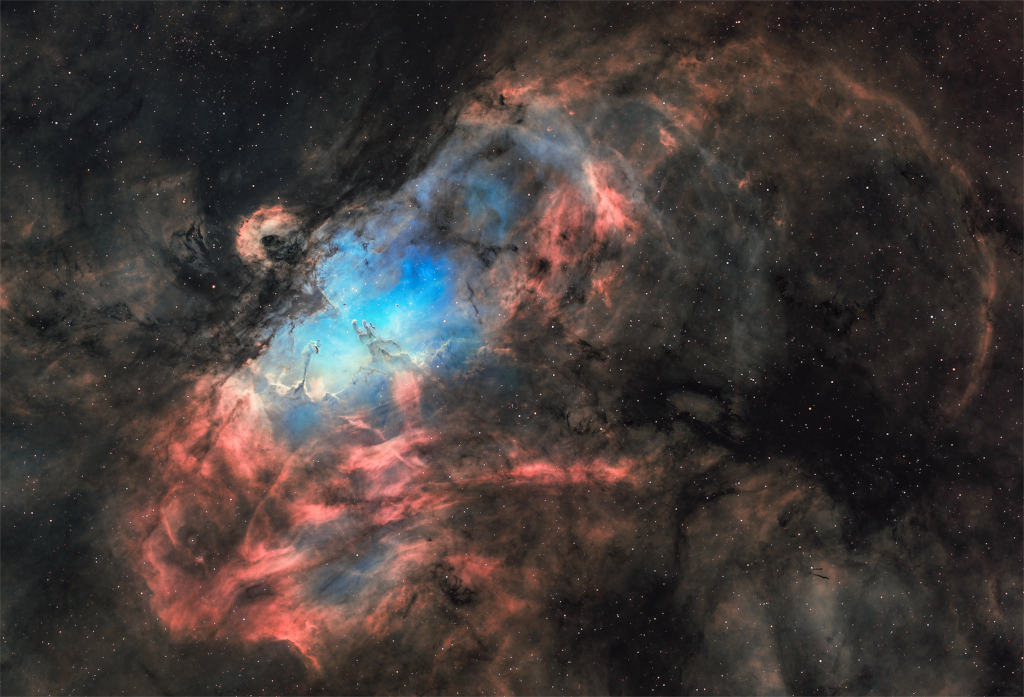12. August 2022
鴟鴞星雲 ê 肖像

探索宇宙1!逐工會揀一幅無仝款 ê 影像抑是相片,𤆬你熟似咱這个迷人 ê 宇宙,閣有專業天文學者2為你3解說4。
- 原始文章:Portrait of the Eagle Nebula
- 影像來源 kah 版權:Charles Bonafilia
- 台文翻譯:An-Li Tsai (NCU)
[漢羅] 鴟鴞星雲 ê 肖像
Messier 16 (M16) 嘛叫做鴟鴞星雲,伊是一个 200 萬歲 ê 少年星團,tī 會生出新恆星 ê 塗粉 kah 發光氣體雲內底。 這張相片有記錄著這區 ê 美麗細節,伊面頂 ê 色彩,是用多彩 ê Hubble 色盤疊出來--ê。 Hubble 太空望遠鏡 tùi 這區恆星形成複合體 ê 特寫,予這个 宇宙雕塑 變做足出名--ê。 這个景色就親像是 象管,嘛會當叫做 創生之柱。 這个 ùi 中央生出來--ê,厚塗粉、幾若光年長 ê 柱仔雲,是當咧進行重力收縮,未來會形成新恆星 ê 區域。 星團內底 ê 高能輻射會 kā 伊附近 ê 物質侵蝕去,落尾會予內底 ê 新恆星顯露出來。 Ùi 中央倒爿 有較光發射線 ê 塗粉山龍延伸出去 ê 柱仔雲,是另外一个厚塗粉 ê 恆星形成區,伊就叫做 鴟鴞星雲的仙女。 M16 離咱有 7000 光年遠,是一个用雙筒千里鏡 抑是 細台天文望遠鏡 就會當看著 ê 目標。 伊就 tī 天頂 厚星雲、去予分做頭尾兩爿 ê 巨蛇座尾(蛇 ê 尾溜)遐。 這張鴟鴞星雲 ê 望遠鏡肖像差不多有 70 光年闊。
[POJ] Ba̍h-hio̍h-seng-hûn ê siàu-siōng
Messier 16 (M16) mā kiò-chò Ba̍h-hio̍h-seng-hûn, i sī chi̍t-ê 200 bān hòe ê siàu-liân seng-thoân, tī ē siⁿ--chhut sin hêng-chhiⁿ ê thô͘-hún kah hoat-kng khì-thé-hûn lāi-té. Chit-tiuⁿ siòng-phìⁿ ū kì-lio̍k tio̍h chit-khu ê bí-lē sè-chiat, i bīn-téng ê sek-chhái, sī iōng to-chhái ê Hubble sek-pôaⁿ tha̍h chhut-lâi--ê. Hubble Thài-khong-bōng-oán-kiàⁿ tùi chit-khu hêng-chhiⁿ hêng-sêng ho̍k-ha̍p-thé ê te̍k-siá, hō͘ chit-ê ú-tiū tiau-sok piàn-chò chiok chhut-miâ--ê. Chit-ê kéng-sek to̍h chhin-chhiūⁿ sī chhiūⁿ-kńg, mā ē-tàng kiò-chò Chhòng-seng-chi-thiāu. Chit-ê ùi tiong-ng siⁿ--chhut-lâi--ê, kāu thô͘-hún, kúi-ā kng-nî tn̂g ê thiāu-á-hûn, sī tng-leh chìn-hêng tiōng-le̍k siu-sok, bī-lâi ē hêng-sêng sin hêng-chhiⁿ ê khu-he̍k. Seng-thoân lāi-té ê ko-lêng hok-siā ē kā i hū-kīn ê bu̍t-chit chhim-sit khì, lo̍h-bóe ē hō͘ lāi-té ê sin hêng-chhiⁿ hián-lō͘ chhut-lâi. Ùi tiong-ng tò-pêng ū khah kng hoat-siā-sòaⁿ ê thô͘-hún soaⁿ-lêng iân-sin chhut-khì ê thiāu-á-hûn, sī lēng-gōa chi̍t-ê kāu thô͘-hún ê hêng-chhiⁿ hêng-sêng-khu, i to̍h kiò-chò Ba̍h-hio̍h-seng-hûn ê Sian-lú. M16 lī lán ū 7000 kng-nî hn̄g, sī chi̍t-ê iōng siang-tâng chhian-lí-kiàⁿ iah-sī sè-tâi thian-bûn bōng-oán-kiàⁿ to̍h ē-tàng khòaⁿ--tio̍h ê bo̍k-piau. I to̍h tī thiⁿ-téng kāu seng-hûn, khì hō͘ pun-chò thâu-bóe nn̄g-pêng ê Kū-siâ-chō Bóe (Chôa ê bóe-liu) hiah. Chit-tiuⁿ Ba̍h-hio̍h seng-hûn ê bōng-oán-kiàⁿ siàu-siōng chha-put-to ū 70 kng-nî khoah.
[KIP] Ba̍h-hio̍h-sing-hûn ê siàu-siōng
Messier 16 (M6) mā kiò-tsò Ba̍h-hio̍h-sing-hûn, i sī tsi̍t-ê 200 bān huè ê siàu-liân sing-thuân, tī ē sinn--tshut sin hîng-tshinn ê thôo-hún kah huat-kng khì-thé-hûn lāi-té. Tsit-tiunn siòng-phìnn ū kì-lio̍k tio̍h tsit-khu ê bí-lē sè-tsiat, i bīn-tíng ê sik-tshái, sī iōng to-tshái ê Hubble sik-puânn tha̍h tshut-lâi--ê. Hubble Thài-khong-bōng-uán-kiànn tuì tsit-khu hîng-tshinn hîng-sîng ho̍k-ha̍p-thé ê ti̍k-siá, hōo tsit-ê ú-tiū tiau-sok piàn-tsò tsiok tshut-miâ--ê. Tsit-ê kíng-sik to̍h tshin-tshiūnn sī tshiūnn-kńg, mā ē-tàng kiò-tsò Tshòng-sing-tsi-thiāu. Tsit-ê uì tiong-ng sinn--tshut-lâi--ê, kāu thôo-hún, kuí-ā kng-nî tn̂g ê thiāu-á-hûn, sī tng-leh tsìn-hîng tiōng-li̍k siu-sok, bī-lâi ē hîng-sîng sin hîng-tshinn ê khu-hi̍k. Sing-thuân lāi-té ê ko-lîng hok-siā ē kā i hū-kīn ê bu̍t-tsit tshim-sit khì, lo̍h-bué ē hōo lāi-té ê sin hîng-tshinn hián-lōo tshut-lâi. Uì tiong-ng tò-pîng ū khah kng huat-siā-suànn ê thôo-hún suann-lîng iân-sin tshut-khì ê thiāu-á-hûn, sī līng-guā tsi̍t-ê kāu thôo-hún ê hîng-tshinn hîng-sîng-khu, i to̍h kiò-tsò Ba̍h-hio̍h-sing-hûn ê Sian-lú. M6 lī lán ū 7000 kng-nî hn̄g, sī tsi̍t-ê iōng siang-tâng tshian-lí-kiànn iah-sī sè-tâi thian-bûn bōng-uán-kiànn to̍h ē-tàng khuànn--tio̍h ê bo̍k-piau. I to̍h tī thinn-tíng kāu sing-hûn, khì hōo pun-tsò thâu-bué nn̄g-pîng ê Kū-siâ-tsō Bué (Tsuâ ê bué-liu) hiah. Tsit-tiunn Ba̍h-hio̍h sing-hûn ê bōng-uán-kiànn siàu-siōng tsha-put-to ū 70 kng-nî khuah.
[English] Portrait of the Eagle Nebula
A star cluster around 2 million years young surrounded by natal clouds of dust and glowing gas, Messier 16 (M16) is also known as The Eagle Nebula. This beautifully detailed image of the region adopts the colorful Hubble palette and includes cosmic sculptures made famous in Hubble Space Telescope close-ups of the starforming complex. Described as elephant trunks or Pillars of Creation, dense, dusty columns rising near the center are light-years in length but are gravitationally contracting to form stars. Energetic radiation from the cluster stars erodes material near the tips, eventually exposing the embedded new stars. Extending from the ridge of bright emission left of center is another dusty starforming column known as the Fairy of Eagle Nebula. M16 lies about 7,000 light-years away, an easy target for binoculars or small telescopes in a nebula rich part of the sky toward the split constellation Serpens Cauda (the tail of the snake). As framed, this telescopic portrait of the Eagle Nebula is about 70 light-years across.
詞彙學習
| 漢羅 | POJ | KIP | 華語 | English |
|---|---|---|---|---|
| 鴟鴞星雲 | Ba̍h-hio̍h-seng-hûn | Ba̍h-hio̍h-sing-hûn | 老鷹星雲 | the Eagle Nebula |
| 星團 | seng-thoân | sing-thuân | 星團 | star cluster |
| Hubble 色盤 | Hubble sek-pôaⁿ | Hubble sik-puânn | 哈伯色盤 | Hubble palette |
| Hubble 太空望遠鏡 | Hubble Thài-khong Bōng-oán-kiàⁿ | Hubble Thài-khong Bōng-uán-kiànn | 哈伯太空望遠鏡 | Hubble Space Telescope |
| 象管 | chhiūⁿ-kńg | tshiūnn-kńg | 象鼻 | elephant trunks |
| 創生之柱 | Chhòng-seng-chi-thiāu | Tshòng-sing-tsi-thiāu | 創生之柱 | Pillars of Creation |
| 恆星形成區 | hêng-chhiⁿ hêng-sêng-khu | hîng-tshinn hîng-sîng-khu | 恆星形成區 | starforming region |
| 恆星形成複合體 | hêng-chhiⁿ hêng-sêng ho̍k-ha̍p-thé | hîng-tshinn hîng-sîng ho̍k-ha̍p-thé | 恆星形成複合體 | starforming complex |
| 鴟鴞星雲的仙女 | Ba̍h-hio̍h-seng-hûn ê Sian-lú | Ba̍h-hio̍h-sing-hûn ê Sian-lú | 老鷹星雲的仙女 | Fairy of Eagle Nebula |
| 雙筒千里鏡 | siang-tâng chhian-lí-kiàⁿ | siang-tâng tshian-lí-kiànn | 雙筒望遠鏡 | binoculars |
| 天文望遠鏡 | thian-bûn bōng-oán-kiàⁿ | thian-bûn bōng-uán-kiànn | 天文望遠鏡 | telescope |
| 巨蛇座尾 | Kū-siâ-chō Bóe | Kū-siâ-tsō Bué | 巨蛇座尾 | Serpens Cauda |
| 肖像 | siàu-siōng | siàu-siōng | 肖像 | portrait |
| Messier 16 | Messier cha̍p-la̍k | Messier tsa̍p-la̍k | Messier 16 | Messier 16 (M16) |